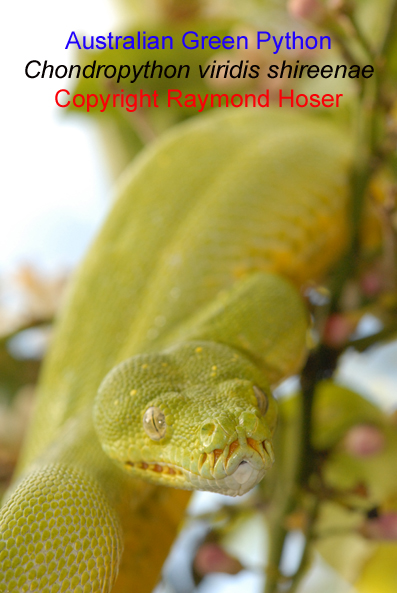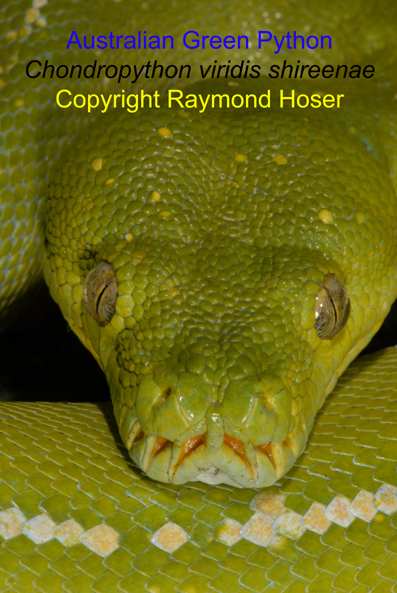GREEN PYTHON TAXONOMY – AS OF 2009
NOW THERE ARE 2 SPECIES AND 2 MORE SUBSPECIES
These
are:
Chondropython
viridis (Schlegel 1872), southern New Guinea
generally and offshore Islands.
Chondropython
viridis shireenae Hoser 2003, Australia only.
Chondropython
viridis adelynhoserae Hoser 2009, Normanby
Island, New Guinea.
Chondropython azureus Meyer 1875, New Guinea north of the central range, including
offshore islands.
Many
authors call Green Pythons “Morelia viridis”.
The
following is taken from the paper:
CHONDROPYTHON MEYER 1874
Designation of
so-called “Green Pythons” in the genus Chondropython
has been the normal situation among taxonomists for most of the past 100
years. Having said this, in recent
times a number of taxonomists lump the Green Pythons in the genus Morelia, noting the obvious affinities
between the two groups.
Hobbyists still call
the snakes “Chondro’s” regardless of what scientific name they use.
Allowing for the
latter placement of these snakes in the supergenus “Morelia”, these snakes remain outside the core Morelia group of “Carpet Pythons”, with the Australiasis snakes (so-called Scrub Pythons) also forming a
different group.
If one doesn’t accept
the obvious splits to include the genera Australiasis,
Lenhoserus and Chondropython, then all preceding names are available at the
subgenus level.
For the purposes of
this paper and following on from Hoser 2000b, Chondropython is treated here as a full genus.
Rawlings and Donellan
(2003) in their Phylogeographic Analysis of the Green Python, yielded results
in accordance with similar studies for other snake genera with similar cross
New Guinea distributions, including Acanthophis
(Hoser 1998), Leiopython (Hoser 2000)
and Australiasis (Harvey et. al.
2000).
 While Hoser 1998 and
Hoser 2000b did not relate the findings with geological evidence in terms of
seeking explanations for results, other authors including Harvey et. al. (2000)
have.
While Hoser 1998 and
Hoser 2000b did not relate the findings with geological evidence in terms of
seeking explanations for results, other authors including Harvey et. al. (2000)
have.
That is that as a
result of the formation and uplifting of the central New Guinea range
commencing about 5 million years before present, species were split into
allopatric groups which in turn speciated, giving the present day results.
Hence the barriers
affecting one species seems to have similarly affected others, giving a near
mirror image distribution patterns for the various python genera (as diagnosed
by Hoser 2000b) and also perhaps elapid groups as well.
That Rawlings and
Donellan found evidence to support two species of Green Python was not a
surprise and had been anticipated by hobbyist keepers for decades.
They wrote:
“The pattern of
relationships found for mitochondrial and nuclear genes suggests the presence
of two species of M. viridis, one
present north of the central cordillera and the other present in Southern New
Guinea and Australia.”
Their mtDNA evidence
in terms of the outlier Australian population concurred with Hoser 2000b and
McDowell 1975 in that while it had clear affinities to the southern New Guinea
snakes, they were derived from them in relatively recent geological time and by
a migration south from the main population.
Hobbyist keepers in
Europe and the USA were well aware of the different pattern morphs from
different locations over many years, including differences between those from
north and south of the main dividing range.
While Rawlings and
Donellan 2003 didn’t concern themselves with nomenclature of the regional forms
of Green Python, all taxa have been named at the species level. This contradicts Rawlings et. al. 2008, p.
604, who state the northern New Guinea taxon is “unnamed”, when in fact it was
named in 1875 by Meyer.
Furthermore one of two obvious subspecies, the Australian Green Python (Chondropython viridis shireenae) Hoser
2003 has also been named.
A second highly
distinct form of Green Python, hitherto unnamed and from Normanby Island, Milne
Bay Province, PNG, is formally described for the first time here as the
subspecies Chondropython viridis
adelynhoserae subsp. nov.
That these snakes
differ from other Chondropython has
been speculated for some time. However
until recently I had not seen any specimens in life or good quality photos of
specimens in life. DNA evidence as
provided by Rawlings and Donnellan 2003 also supports the hypothesis that these
snakes differ from other Chondropython
and are reproductively isolated from them and have been for some time.
For the record, Chondropython pulcher Sauvage 1878, is a
synonym of C. azureus Meyer 1875
being derived from the same general region as C. azureus.
Chondropython viridis Adelynhoserae subsp. nov.
 Holotype:
A specimen in the Australian Museum R129716, from Normanby Island, Milne Bay,
Papua New Guinea.
Holotype:
A specimen in the Australian Museum R129716, from Normanby Island, Milne Bay,
Papua New Guinea.
Diagnosis:
This is the form of Green Python restricted to Normanby
Island, Milne Bay Province, PNG.
It is separated from
all other Chondropython in New Guinea
and Australia by it’s adult dorsal pattern of (smallish) white blotches that in
the main do not cover the spinal ridge, as seen in all other Australian and
other PNG Chondropython.
Sometimes Chondropython from elsewhere will have
similar blotches, but invariably, these snakes either also have a mid-dorsal
line or dots (not seen in adelynhoserae),
or the blotches run well over the spinal (mid dorsal) mid-line.
MtDNA for the
holotype was examined by Rawlings and Donellan 2003 and compared with other Chondropython yielding traits broadly in
line with C. viridis viridis (but a
three per cent sequence divergence) (see p. 41 their paper). Having said that, it also shared five
nucleotide substitutions that would otherwise be synapomorphies of the northern
lineage, one of which is an indel.
This result in terms
of mtDNA and base pair analysis, as published by Rawlings and Donellan 2003,
forms an additional and/or alternative diagnostic means of identifying and
separating C. v. adelynhoserae subsp.
nov. from other Chondropython.
In other words, the
taxon C. v. adelynhoserae subsp. nov.
can be separated from other C. viridis by
the degree of base pair separation/divergence of mtDNA and/or nuclear DNA as
detailed by Rawlings and Donellan 2003.
This is the only Chondropython taxon found on Normanby
Island, Milne Bay Province, PNG and is allopatric to all other C. viridis or C. azureus.
Etymology:
Named after the elder daughter of this author, Adelyn (pronounced: Adder-lyn)
Hoser, in honor of her valuable education work at educational reptile
demonstrations and the like, including from the age of five safely handling
venomoid versions of the world’s five deadliest snake genera, namely Parademansia, Oxyuranus, Pseudonaja, Notechis and Acanthophis and most importantly after five years of doing so,
never having had a single bite! This emphatically proves that the best way to
avoid snakebites is to be nice to them.
CHONDROPYTHON SUMARY
Based on what is now
believed to be allopatric distribution and factors outlined elsewhere, the
named taxa of Green Python are now as follows:
Chondropython
viridis (Schlegel 1872), southern New Guinea generally and offshore
Islands.
Chondropython
viridis shireenae Hoser 2003, Australia only.
Chondropython
viridis adelynhoserae subsp. nov. (this paper), Normanby
Island, New Guinea.
Chondropython
azureus Meyer 1875, New Guinea north of the central range, including
offshore islands.
Maxwell (2005), gave
detailed information about local “races” of Chondropython,
including from islands. However noting
the extreme phenotypic variation of the genus and the non-sampling of
intermediate populations (when available), and the added variables of local
adaptations to altitude and so on resulting in localized colour variants and
the like, there is no evidence that any of the forms identified in the book
warrant recognition beyond the taxa (to subspecies level) identified in this
paper based on available evidence, most notably that of Rawlings and Donnellan
2003.
Notwithstanding this,
the book remains mandatory reading for those with an interest in the genus.
The above
is taken from the paper:
Click on
the above text to download the paper in full.
Webpage keywords include:Green Python Chondropython viridis, Australia, Australian, Chondropython viridis shireenae, Chondropython azureus is from Northern New Guinea, species and subspecies, Chondropython adelynhoserae is from Normanby Island, PNG, Meyer, Hoser, 2009, Hoser 2003, Green Tree Python, Chondropython nominate form is from southern New Guinea and nearby Islands
